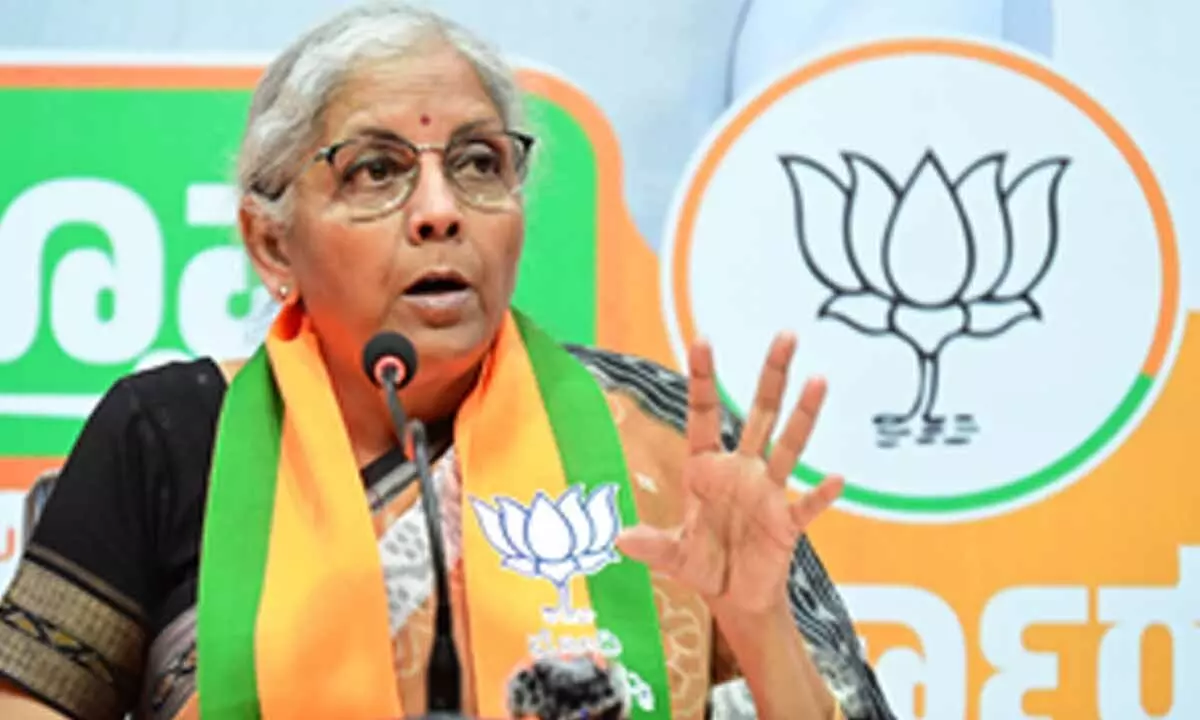Where will funds for Congress’ ‘Khata-Khat’ schemes come from, asks Nirmala Sitharaman
Share :

Finance Minister Nirmala Sitharaman on Monday fired a fresh salvo against Rahul Gandhi and the Congress, for making “lofty promises disconnected with reality” during the Lok Sabha poll campaign without explaining where the huge funds to finance these schemes were going to come from.
New Delhi: Finance Minister Nirmala Sitharaman on Monday fired a fresh salvo against Rahul Gandhi and the Congress, for making “lofty promises disconnected with reality” during the Lok Sabha poll campaign without explaining where the huge funds to finance these schemes were going to come from.
The Finance Minister said that these schemes could not be implemented without increasing taxes or borrowing heavily and running down the economy.
The Finance Minister said on X: “Has @INCIndia considered the cost of the lofty promises made in their manifesto? Have they calculated how much the 'Khata Khat' schemes will cost fiscally? Will they borrow substantially for them, or will they raise taxes to fund them? How many welfare schemes would @RahulGandhi shut down to accommodate the fiscal cost of the 'Khata Khat' schemes?”
The Finance Minister asked would Rahul Gandhi care to answer these questions and explain how their gigantic schemes of fiscal splurge would work without increasing taxes or borrowing heavily and running down the economy.
“Here’s a challenge to him to answer these questions for the people of India,” she said.
She said that the truth is that the BJP government's fiscal management is much better than that of the UPA despite facing the COVID-19 pandemic in which substantial resources were used for relief efforts.
She also asserted that the Modi government had managed the country’s fiscal situation in a much better manner than the Congress-led UPA government and cited figures to drive home her point.
“During the UPA rule from FY2004 to FY2014, Central Government Debt, including external debt at current values, grew about 3.2 times, from Rs 18.74 lakh crore in March 2004 to Rs 58.59 lakh crore in March 2014. This increase was much greater than the 2.9 times growth from Rs 58.59 lakh crore in FY 2014 to Rs 172.37 lakh crore in FY 2024 (RE),” she said.
This lower increase between FY 2014 and FY 2024 occurred despite the impact of the COVID-19 pandemic, where the Centre borrowed to provide relief to those in need even as revenues fell, she added.
She said that the Central government’s debt, which was 52.2 per cent of GDP at the end of FY 2013-14, was reduced to around 48.9 per cent in FY 2018-19 through gradual fiscal consolidation.
“During this period, the fiscal deficit was lowered from 4.5 per cent in FY 2013-14 to 3.4 per cent in FY 2018-19. However, due to the COVID-19 pandemic and proactive government measures to protect lives and livelihoods, the fiscal deficit surged to 9.2 per cent of GDP in FY 2020-21, increasing the central government’s debt to 61.4 per cent of GDP,” the Finance Minister said.
She said that post-pandemic, the government pursued a balanced approach to fiscal consolidation while sustaining economic growth.
“This strategy reduced the fiscal deficit from 9.2 per cent of GDP in FY 2020-21 to 5.8 per cent in the Revised Estimates for FY 2023-24,” she said.
The minister said that the Interim Budget projects a further reduction to 5.1 per cent of GDP in FY 2024-25. Similarly, the Central government's debt-to-GDP ratio fell from 61.4 per cent in FY 2020-21 to 57.1 per cent in FY 2023-24.
“On the other hand, under UPA, for 6 consecutive years between FY 2009 and FY 2014, the ratio of India's Gross Fiscal Deficit (GFD) to Gross Domestic Product (GDP) was at least 4.5 per cent. It was between 4.5 per cent - 5 per cent of GDP in 3 out of the 6 years, between 5 per cent - 6 per cent in one, and more than 6 per cent in 2 years. And there was no COVID-19-like crisis that needed such a quantum of fiscal expansion, showing poor fiscal management by UPA,” the Finance Minister said.
The Net Market Borrowings (G-sec) of the Centre had gone up a whopping 4.5 times during the UPA regime. It went up by 2.6 times under our government despite the COVID-19 pandemic. It shows the robust fiscal management of our govt, she added.
During COVID-19, ‘borrow, spend and even print money’ to reboot the economy was the predominant advice given by the so-called “luminaries” of the opposition parties led by Congress. Ironically, the same people are complaining about high debt levels, the Finance Minister remarked.
Under the Congress-led UPA government, the underlying deficit was much higher than the budgeted deficit, she said.
UPA Govt did ‘window dressing’ to hide its high fiscal deficit without maintaining the integrity of the fiscal numbers. Fiscal Deficit for 2008-09 would have been 7.9 per cent instead of 6.1 per cent as officially stated, she said.
“In contrast, our government has prioritised transparency and accountability in its budgeting practices, thereby enhancing the credibility and robustness of its fiscal numbers,” the Finance Minister added.

















